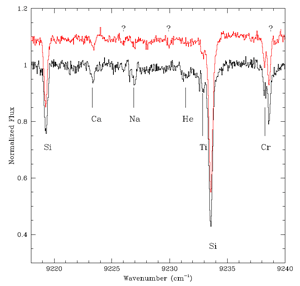- Details
- Published on 03 June 2011
Vol. 531In section 5. Galactic structure, stellar clusters and populations
Measuring helium abundance difference in giants of NGC 2808

One explanation for the presence of multiple populations in globular clusters is a spread in the helium abundance within these clusters. Helium is notoriously difficult to detect in evolved stars. There is a weak He I line at 10830 Angstroms, which has recently become accessible with new high-resolution infrared spectrographs, such as CRIRES at the VLT. The authors used VLT/CRIRES and VLT/UVES to observe two giant stars in globular cluster NGC2808 with similar stellar parameters, but different Na and O abundances, hence presumed to belong to different subpopulations. These two stars show very similar Ca II and Hα chromospheric lines, but only the Na- rich star shows any He I detection. This leads to inferring an abundance difference of ΔY ≥ 0.17. This is the first tentative direct detection of an He abundance variation in a classical globular cluster, and it is consistent with expectations from stellar evolution theory.


